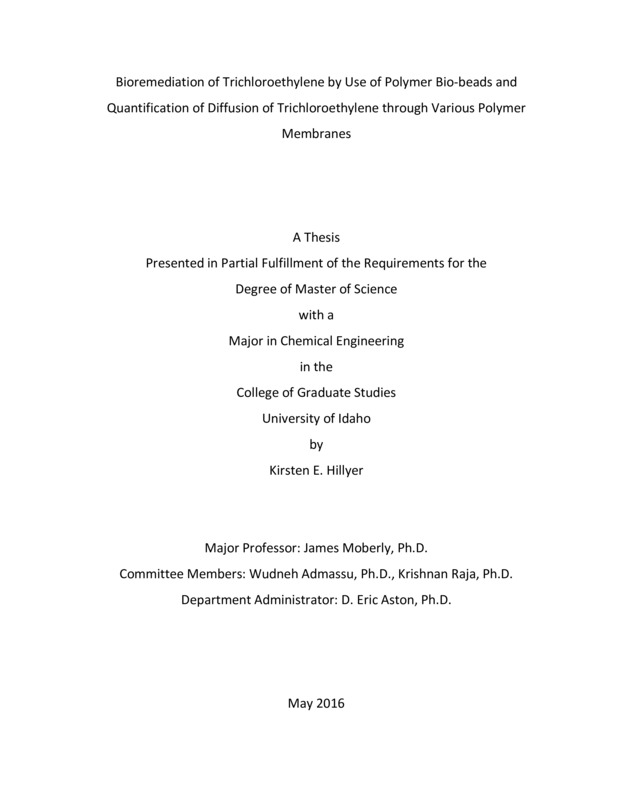Bioremediation of Trichloroethylene by Use of Polymer Bio-beads and Quantification of Diffusion of Trichloroethylene through Various Polymer Membranes
Hillyer, Kirsten. (2016). Bioremediation of Trichloroethylene by Use of Polymer Bio-beads and Quantification of Diffusion of Trichloroethylene through Various Polymer Membranes. Theses and Dissertations Collection, University of Idaho Library Digital Collections. https://www.lib.uidaho.edu/digital/etd/items/hillyer_idaho_0089n_10921.html
- Title:
- Bioremediation of Trichloroethylene by Use of Polymer Bio-beads and Quantification of Diffusion of Trichloroethylene through Various Polymer Membranes
- Author:
- Hillyer, Kirsten
- Date:
- 2016
- Embargo Remove Date:
- 2018-05-12
- Program:
- Chemical and Materials Science Engineering
- Subject Category:
- Chemical engineering; Environmental engineering
- Abstract:
-
Trichloroethylene is a wide spread carcinogenic contaminate in groundwater, present in roughly 60% America’s Superfund sites. Beginning in the early 1900’s, TCE was commonly used as an anesthetic, food processing agent, industrial degreaser, and dry cleaning agent. In 1989 the Environmental Protection Agency (EPA) implemented a maximum contaminate level (MCL) on chlorinated solvents such as TCE. Although TCE usage is strictly regulated now, the previous 100+ years of usage has left a significant amount of contamination in the environment worldwide.
TCE is a dense non-aqueous phase liquid (DNAPL), making it particularly difficult to remediate. TCE travels down through groundwater until it reaches a confining layer, resulting in a persistent contamination problem for decades. Bioremediation has moved to the forefront as cost effective treatment technology for the remediation of chlorinated aliphatic hydrocarbons (CAHs), but many of these methods are still in the research phase due to the struggles the environment presents. Elevated dissolved oxygen, low pH, and high concentration of contaminates contribute to the inability of unprotected microorganisms to effectively reduce TCE. Encapsulation of microorganisms into “bio-beads” presents an opportunity to address each of these environmental challenges.
For this thesis bio-beads, were developed utilizing biodegradable polymer and a reductive dechlorinating bacterium consortia known as KB-1, were subjected to various concentrations of TCE. The TCE rate of degradation was monitored to assess the kinetics of TCE reduction and organism viability. To better understand the mass transfer of TCE through the bio-beads, the diffusion coefficient of TCE through the various polymers used to create the beads was quantified. The quantification was completed by casting the polymers in membranes. With the quantification of the diffusion coefficient of TCE through various polymer membranes, development of the bio-beads can be modified in the future to improve the reaction kinetics of the bioremediation of TCE.
- Description:
- masters, M.S., Chemical and Materials Science Engineering -- University of Idaho - College of Graduate Studies, 2016
- Major Professor:
- Moberly, James
- Committee:
- Admassu, Wudneh; Raja, Krishnan
- Defense Date:
- 2016
- Identifier:
- Hillyer_idaho_0089N_10921
- Type:
- Text
- Format Original:
- Format:
- application/pdf
- Rights:
- In Copyright - Educational Use Permitted. For more information, please contact University of Idaho Library Special Collections and Archives Department at libspec@uidaho.edu.
- Standardized Rights:
- http://rightsstatements.org/vocab/InC-EDU/1.0/

